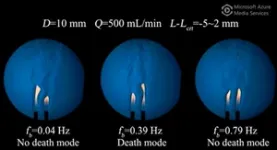Overview
A research team, led by Professor Yuji Nakamura of the Department of Mechanical Engineering at Toyohashi University of Technology, discovered that the flickering of flames can be freely controlled by moving two flames closer together or further apart. Until now, it had been known that interference between flames separated by a certain distance causes the flames to flicker during in-phase or anti-phase. However, it was not possible to stably express the state of “stopping the flickering of flames” that should occur under critical conditions where the phase changes.
The research team succeeded in stably expressing the state of “stopping the flickering of flames” by periodically adjusting the distance between flames closer and further apart. This makes it possible to freely control the flickering of the flames, and to elucidate the essence of flickering flames.
Details
The flickering of flames is a very familiar phenomenon that is easy to observe. At the same time, it is also a mysterious and interesting phenomenon with vast complexity. For example, once the flickering flames have interfered with each other, only the stable flickering mode is selectively expressed. Depending on the distance between the flames, the “in-phase mode” that fluctuates in the same phase and the “anti-phase mode” that fluctuates in the opposite phase are selectively expressed. There are also mysterious phenomena such as different fluctuation frequencies in those modes. In this way, it is possible to achieve various fluctuating states. Still, there is no example that shows “stopping the flickering by interfering with the fluctuating flames.” In the past, it was shown that this state can be achieved by arranging three flames (known as “death mode” in reference to the complete absence of movement). However, researchers have yet to understand the reason why death mode cannot be achieved with two flames.
When examining this theme, the research team found that the death mode is expressed by adjusting the distance between the two flames closer or further apart in a certain cycle.
“When conducting experiments involving flame-to-flame interference, flickering will temporarily stop if the flames are gradually brought closer or further apart,” explains Dr. Ju Xiaoyu, lead author and researcher at the time of the project. “However, if the flames are kept in that position, they will eventually start flickering again. Since the flames eventually flicker, we know that flickering is a stable state. The fact that there is a delay period until the flames settle into a stable state means that if we can create a situation where flickering can be stopped within that time scale, the flickering should be stopped permanently. We were able to prove that this prediction is correct by periodically adjusting the distance between flames closer and further apart. We also demonstrated that the reason for this phenomenon can be explained by hydrodynamic properties. Moving forward, we will proceed with research aimed at constructing a theory.”
Development Background
“It has been known that the flame flickering mode is determined by interference between flames,” says Professor Yuji Nakamura, leader of the research team. “Researchers in applied physics have attempted to explain this phenomenon as nonlinear physics instead of combustion engineering. Nevertheless, their explanation felt inadequate to me due to its failure to consider hydrodynamics. In response, I began to earnestly research this theme. I was amazed to witness a phenomenon in which flickering temporarily stopped in an intermediate state between in-phase and anti-phase flickering. I felt a strong desire to elucidate this mysterious transition state, a theme which has not been addressed by previous research. From the beginning, I had the idea of constantly adjusting the distance between flames to take advantage of the time delay until they settled into a stable state. Ultimately, I was able to organize this method with the help of Dr. Ju.”
Professor Nakamura concludes: “Introducing this phenomenon at events such as academic conference is sure to capture the interest of the audience without exception. However, the audience will, without exception, raise questions regarding examples of practical application. For example, ‘How can these findings be used?’ I repeatedly answered such questions by posing my own question—‘Actually, I only began researching this phenomenon out of personal curiosity, so I’d like to ask how you think my findings can be used?’ This experience has led me to start my research presentations by asking the audience to refrain from questions on practical application. I believe that one appeal of conducting basic research at a university is being able to purely immerse yourself in curiosity, without the need to consider practical application.”
Future Outlook
Although the research team is not considering practical application of their research at the present time, they plan to delve deeper into the theme not only through experiments, but also through numerical and theoretical analysis. This will be done in the name of basic research that is unique to universities; that is, through the elucidation of mysterious phenomenon. The team plans to proceed as international joint research in collaboration with Dr. Ju and many international researchers who have expressed interest in their research. Through the international dissemination of research seeds originating in Japan, the team would like to convey to the world that this kind of (currently impractical) basic research can be pursued vigorously in Japan.
Reference
Ju, X., Bunkwang, A., Yamazaki, T., Matsuoka, T., and Nakamura, Y., "Flame Flickering Can Cease under Normal Gravity and Atmospheric Pressure in a Horizontally Moving Dual Burner System", Physical Review Applied, Vol.19, No.1 (2023.1) eid 014060
DOI: 10.1103/PhysRevApplied.19.014060
https://journals.aps.org/prapplied/abstract/10.1103/PhysRevApplied.19.014060
END









